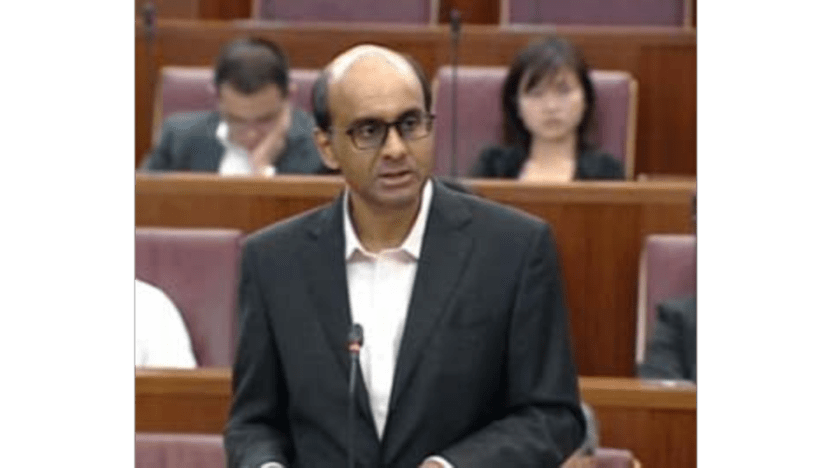Budget to build inclusive society, stronger Singapore
Among the significant moves were measures to cut Singapore's dependence on foreign workers, improve productivity and address the issue of income inequality.

Tharman Shanmugaratnam
SINGAPORE: Deputy Prime Minister and Minister for Finance Tharman Shanmugaratnam on Friday delivered Budget 2012 aimed to build an inclusive society and a stronger Singapore.
Among the significant moves were measures to cut Singapore's dependence on foreign workers, improve productivity and address the issue of income inequality.
There were also incentives for Singapore companies to hire older workers while the employers' contributions to the compulsory Central Provident Fund (CPF) for older workers would be raised.
Bold moves were introduced to get companies to focus on increasing productivity, with the long-term goal of growing productivity by 2 to 3 percent a year.
Among them were steps to reduce the dependency on foreign workers, coming on the heels of similar measures introduced in 2010.
Mr Tharman said: "It will take time for these measures to have an effect on businesses' demand for foreign workers. The foreign workforce has in the meantime grown rapidly, by 7.5% per year over the last two year and is now at about one-third of our total workforce.
"This has happened in an environment of full employment for Singaporeans and shortage of labour in many sectors of the economy. We have no alternative but to slow down the growth of our foreign workforce."
From July, the Dependency Ratio Ceilings (DRC) will be reduced for the manufacturing and services sector.
The ratio specifies the maximum proportion of foreign workers to Singapore workers a company can hire.
Mr Tharman gave the assurance though that companies will be given time to adjust. Companies will be given until June 2014 to comply with the new DRC for existing foreign workers.
Mr Tharman said the two-year transition recognises that many companies would have already invested in their existing workers.
Companies will be encouraged to hire locals, and keep older workers. Recognising that such a move will hit small and medium enterprises hard, the government will give employers special help in the form of a wage subsidy for hiring workers aged 50 and above. This wage subsidy is known as enhance Special Employment Credit.
Other measures include a one-off cash grant for small and medium enterprises pegged at 5 percent of a company's revenue for the Year of Assessment 2012.
On the social front, there will be more help for the elderly, disabled and lower income families as the government moves in to address the issue of income inequality.
Mr Tharman said: "We still see evidence of considerable social mobility, as students from all backgrounds flow through our education system. Take our PSLE cohorts.
"Every year the top students come from schools all around the island, including many neighbourhood schools. And a significant proportion of students from the lower end on the socio-economic scale make it to the top one-third in PSLE performance.
"But it will get more difficult to keep up this mobility in the years to come - precisely because we have achieved a very high degree of mobility in the past, amongst past generations, the parents' generations. We must therefore work harder at this.
"We must find every effective way to help those who start off lower down to catch up and do well; every way to prevent disadvantage from repeating itself across generations."
One main strategy is to reward work. To help workers with their retirement savings, the CPF contribution rates for older Singaporeans will be raised.
From September this year, CPF rates for workers aged 50-55 will be increased by 2.5 percentage points - 2 percentage points from the employer and 0.5 percentage points from the employee. This will bring their total CPF contributions up from 30% to 32.5%.
For workers aged 55-60, their CPF rates will rise by 2 percentage points - 1.5 percentage points from the employer and 0.5 percentage points from the employee.
For those aged 60-65, their employer contribution rate will rise by 0.5 percentage points. There will be no increase in their employee contribution rate.
Mr Tharman said that progressively, the CPF contribution rates for workers aged between 50 and 55 will be raised by 6 percentage points to 36 per cent. This will make the rate on par with younger workers.
"We will have to watch how the employment market develops before making any further moves," said Mr Tharman.
To help the elderly unlock their assets, there will be a $20,000 Silver Housing Bonus for those who want to move to smaller public flats.
The net proceeds from the sale of their home will have to be pumped back into their CPF accounts, which will be matched dollar-for-dollar up to $20,000 by the government.
Healthcare expenditure will double from $4 billion to about $8 billion over the next 5 years. This will go into building better infrastructure from hospitals to home-based care.
For the disabled, there are more measures to support employment. The Special Employment Credit will be extended to employers who hire graduates from Special Education schools (SPED).
To help workers earn more income, the Workfare Income Supplement Scheme will also be extended to all SPED graduates who work.
And signalling the government's long term commitment to help low income groups, a permanent feature called the Goods and Services Tax (GST) Voucher will be introduced.
The government will set aside $3.6 billion for the GST Voucher over the next five years. The aim is to help the poor offset their GST expenses.
The GST Voucher will essentially give cash, top-ups to the Medisave of older Singaporeans and utility rebates for the lower income.
Mr Tharman said: "We all know that building an inclusive society is not just about government redistributing resources to help the poor. It is about building a society where at its heart, people retain a deep sense of responsibility for their families and seek every opportunity to improve themselves and do better."
To deal with a key issue of improving the public transport system, the government will pump in $1.1 billion to ramp up bus capacity by adding 800 more buses on the roads by 2016.
Mr Tharman said the step-up in social programmes makes it critical that Singapore strikes the right balance in its public finances.
For fiscal year 2011, Singapore enjoyed an overall budget surplus of about $2.3 billion - that's equivalent to 0.7 percent of the country's Gross Domestic Product.
This is much higher than its initial estimate of an overall budget surplus of $100 million. The boost is attributed to stronger corporate profits, lower-than-expected claims for capital allowances as well as a sharp increase in stamp duties.











